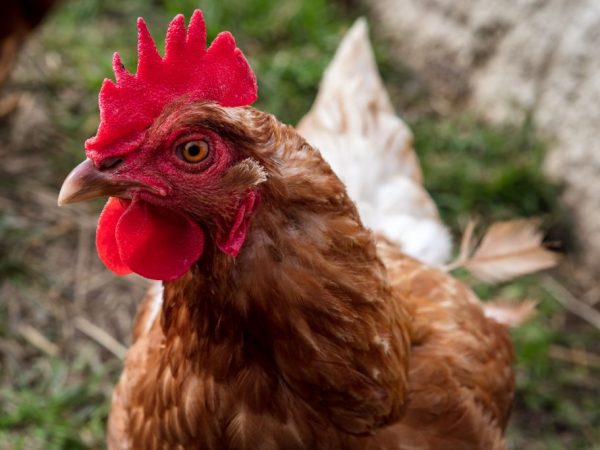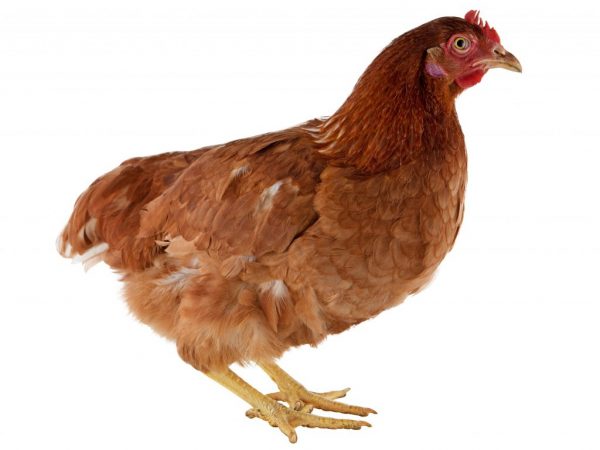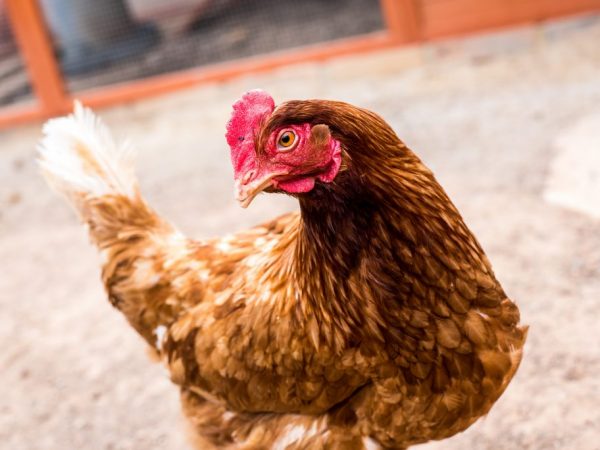Description of the Kuban red breed of chickens
The Kuban red breed of chickens in poultry houses is one of the most popular, although it was bred relatively recently. The official name is “Cross UK Kuban - 7”. Work on improving the bird does not stop, so its quality characteristics are getting better every time.
- Brief information about the breed
- general description
- Appearance
- Character
- Incubation instinct
- Productivity
- Advantages and disadvantages
- Breeding features
- Incubation
- Chicks feeding
- Chick care
- Maintenance of adults
- What should be a chicken coop
- Food
- Place for walking
- Molting
- Age problems
- Possible diseases
- Owner reviews

Kuban red chickens
Brief information about the breed
- Productivity type: egg.
- Rooster weight: 3 kg.
- Chicken weight: 2 kg.
- Ovipositor start: early (after 4 months).
- Egg production: high (340 eggs per year).
- Features of the: increased productivity, demanding on temperature conditions.
- Egg size: large (60-65 g).
- Are they suitable for a beginner: Yes.
general description
Appearance
The Kuban breed is distinguished by its large body and graceful head. Description of external signs:
- short neck, on the head a large red leaf-shaped ridge;
- developed chest;
- low strong paws;
- dense plumage that fits snugly to the body;
- feather color is brown or red;
- blotches of black or gray are found on the wings and tail.
Character
The Kuban red breed has a docile nature, they are unpretentious in feeding. Breeders note a weak resistance to stress in birds.
Chickens can show aggression towards others, for example, when there are harsh loud noises. Roosters are not pugnacious, they have a phlegmatic disposition.
Incubation instinct
The Kuban red hen is not the best brood hen. For the continuation of the offspring, eggs are usually placed in an incubator or under layers of other breeds.
Productivity
The approximate weight of an adult female is 2 kg. The rooster weighs an average of 3 kg. Broiler meat is tasty, a little tough, because the breed belongs to the egg direction.
The hen reaches puberty at 4 months. Under average conditions, the laying hen gives up to 250 eggs per year. If the rules of care are followed to the maximum, then it gives about 340 eggs per year, which is the best indicator of productivity. Egg weight is usually 60-65 g.
Advantages and disadvantages

The breed is distinguished by excellent health
The advantages of breeding the Kuban breed:
- good profitability, both in a private yard and in a poultry farm;
- birds are in good health;
- the survival rate of chickens is 95%;
- in terms of egg production, these birds are in first place;
- a big plus - economical feed consumption.
The disadvantage is the fact that the fertility of chickens is directly dependent on the weather. Birds can hardly endure the summer heat; at temperatures above 27 ° C, they lose their appetite and rush badly. Also, egg production decreases if the temperature drops below 10 ° C in winter.
Breeding features
Incubation
For productive fertilization, there should be one rooster for 10 females.Laying hens usually sit on the nest themselves, but then stop laying. It takes a long time to restore their productivity. Therefore, experts advise to breed the Kuban breed using an incubator.
In order to breed offspring naturally, it is better to take an old hen, which has no value in terms of egg production, as a brood hen.
Chick feeding
In order to obtain healthy offspring, chicks are provided with adequate nutrition from the first day of life. You need to feed the chickens as soon as they dry out. You need to feed young animals 6 times a day.
A boiled finely chopped egg is best suited for feeding. On the second day, you can include seasonal herbs and dairy products in the diet.
Greens should make up about one third of the chicks' total food. They also check that there is always clean fresh water in the drinker. It is also advisable to pour millet and crushed wheat into the feeder so that the chickens have constant access to food.
Chick care
When the chicks are hatched and dry, they should be placed in a separate box that is heated. The easiest way to do it is with an infrared or blue lamp.
Chicks need heating for about 20 days. Then they can be gradually accustomed to room temperature. If weather conditions permit, then starting from the age of two weeks, the chickens are taken out on a fenced-in range.
Maintenance of adults
What should be a chicken coop
In order for the Kuban red breed to maintain a high egg production, high-quality conditions of keeping are necessary.
For birds of this breed, a comfortable air temperature is very important. Optimum 17 ° -19 ° C. In winter, daylight hours should be increased to 12 hours.
If the chicken coop is not heated in winter, then it must be carefully insulated. When the temperature drops to -2 ° C, the hens can freeze the scallops and stop laying eggs.

Birds need to be well cared for
Drafts and dampness are very dangerous for the health of birds. If there are gaps in the room, then in winter they need to be repaired using insulation. In the cold season, there should be at least 20 cm of sawdust litter on the floor.
For laying hens, they will equip comfortable nests with sawdust or hay. It is best to place the nests on the wall, they are covered with lime. It is advisable to thoroughly clean the chicken coop 2 times a year.
If the birds are not being properly cared for, breeders should consider keeping options for other breeds.
Food
To maintain the stable productivity of the Kuban breed, it needs to be provided with a full two meals a day. Cereals make up half of the daily ration.
In addition, the following should be included:
- bran;
- compound feed;
- legumes;
- vegetables;
- greens.
Products containing animal protein are added to the diet of Kuban chickens. It can be meat and bone meal, broth, cottage cheese or dairy products.
It is necessary to ensure that the mash, prepared on the basis of compound feed, are eaten by the birds within half an hour. If they remain in the trough for a longer time, especially during a hot period, the livestock will develop food poisoning.
Chickens of the Kuban breed have a very good metabolism, so they do not lack vitamins and minerals. In summer, it is best to diversify your diet with seasonal herbs. In winter and early spring, you can add food containing vitamins and minerals to the diet.
Birds should always have access to clean, fresh water. In summer it is changed 2 times a day, in winter 1 time is enough.
Place for walking
In poultry farms, this breed is kept only in cages. Providing birds with walking space in a private backyard will improve their health and productivity.
Thanks to the opportunity to walk in open areas, the chicken's diet is enriched, so the eggs become more nutritious and healthy.
It is better to enclose the site, because chickens have a curious character, they can leave.They also make a canopy so that they can hide there from the rain or the scorching sun. It is advisable to install troughs with sand, ash and shells for hygiene procedures.
Molting
Kuban red chickens begin to molt in September. At this time, dense thick feathers replace thin plumage - this is how birds prepare for winter. During this time, egg production temporarily decreases. To help them survive the molt more easily, specialized complexes are added to the diet.
Age problems
The maximum egg production in females is maintained during the first year of life. After one year, the production of hens gradually decreases, but the eggs become larger.
Experienced poultry farmers advise not to leave chickens for the second or third year, but to prepare a new batch by this time.
Possible diseases
With proper care and good nutrition, Kuban red chickens do not have health problems. If mistakes were made in the content, then parasites appear most often in birds.
Periodically, the livestock should be carefully inspected for their presence, as well as preventive measures should be taken.
Owner reviews
Farmers are satisfied with the high egg production of this breed. They also note that the Kuban chickens are friendly, they quickly get used to their hands, and the roosters are completely unhappy. A small amount of feed is consumed for feeding, which always pleases the owners.
Breeders do not like the weak stress resistance of birds. When frightened, they can show aggression, pecking at each other.


